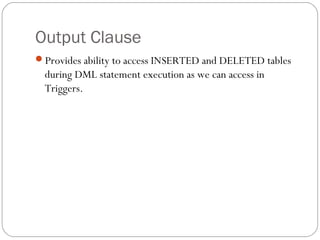7a advanced tsql
- 1. Advanced TSQL SQL Server 2008
- 2. Agenda ïEnhancing DML Functionality ïOutput Clause ïMerge Statement ïManaging Transactions ïImplicit Transaction ïExplicit Transaction ïException Handling ïTryâĶCatch
- 3. Agenda ïExtending SQL Server Functionality ïCTE ïXML ïCLR ïFileStream ïSpatial ïFull Text Search ïService Broker
- 4. Agenda ïApply Operator ïCross Apply ïOuter Apply ïPivoting Data ïPIVOT ïUNPIVOT ïRanking Functions ïROW_NUMBER ïRANK ïDENSE_RANK ïNTILE
- 5. Output Clause ïProvides ability to access INSERTED and DELETED tables during DML statement execution as we can access in Triggers.
- 7. Merge Statement ïProvides you the ability to compare rows between source and target tables, and then performs DML action accordingly only on target Table.
- 9. Managing Transaction ïImplicit Transaction ïSetting mode for implicit transaction ï Manual Commit â Set Implicit_Transactions OFF ï Auto commit â Set Implicit_Transactions ON ïExplicit Transaction ïBegin Transaction [Trans Name] ïCommit Transaction [Trans Name] ïRollback Transaction [Trans Name] ïSavepoint â Save Transaction [Savepoint name]
- 10. Exception Handling (Try..Catch) ïCaptures Error severity higher that 10 ïTryâĶCatch TSQL Begin Try [SQL Statements] End Try Begin Catch [SQL Statements] End Catch
- 11. Retrieving Error Information ï ERROR_NUMBER() returns the number of the error. ï ERROR_SEVERITY() returns the severity. ï ERROR_STATE() returns the error state number. ï ERROR_PROCEDURE() returns the name of the stored procedure or trigger where the error occurred. ï ERROR_LINE() returns the line number inside the routine that caused the error. ï ERROR_MESSAGE() returns the complete text of the error message. The text includes the values supplied for any substitutable parameters, such as lengths, object names, or times.
- 13. CTE ï Like derived tables ï Iterates results sets ï Recursive ï CTE Parts ï With Clause ï CTE Name ï Column Names ï AS keyword ï Anchor Query ï Union All ï Second Query ï Outer Query
- 15. PIVOTING DATA ïMoving rows for a column as columns for aggregate values, reversing that combination as well through unpivot ïParts ïSource Table ïPIVOT/UNPIVOT Operator ïAggregation ïFilter Clause (FOR) ïPivot Table
- 16. Pivot Syntax From (Subquery) AS Source_Table PIVOT ( Aggregate_Function(Column_ST) FOR Column_ST IN (Values in Column_ST) ) AS Pivot_Table
- 17. Apply Operator ïOuter Apply ïCross Apply









![Managing Transaction
ïImplicit Transaction
ïSetting mode for implicit transaction
ï Manual Commit â Set Implicit_Transactions OFF
ï Auto commit â Set Implicit_Transactions ON
ïExplicit Transaction
ïBegin Transaction [Trans Name]
ïCommit Transaction [Trans Name]
ïRollback Transaction [Trans Name]
ïSavepoint â Save Transaction [Savepoint name]](https://image.slidesharecdn.com/7a-advancedtsql-130128181440-phpapp02/85/7a-advanced-tsql-9-320.jpg)
![Exception Handling (Try..Catch)
ïCaptures Error severity higher that 10
ïTryâĶCatch TSQL
Begin Try
[SQL Statements]
End Try
Begin Catch
[SQL Statements]
End Catch](https://image.slidesharecdn.com/7a-advancedtsql-130128181440-phpapp02/85/7a-advanced-tsql-10-320.jpg)






